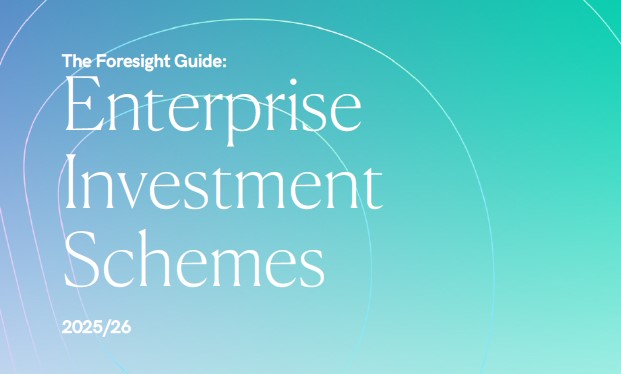What is an Enterprise Investment Scheme (EIS)?
The Enterprise Investment Scheme (“EIS”) is a government initiative that provides a range of tax reliefs for investors who subscribe for qualifying shares in qualifying companies. It was first introduced by the UK Government in 1994 to incentivise investment into smaller UK companies. Investors are incentivised with relief on Income Tax, Capital Gains Tax and Inheritance Tax.
What are the three types of EIS?
EIS Portfolio
Government scheme designed to encourage investment into SMEs, which can be larger, more mature companies. Although qualifying rules determine the companies that can be held, a range of risk is available
Single Investment Company EIS
Investing directly into one business, this strategy is typically used by investment professionals to specifically back companies in which the investor has a lot of confidence
Seed EIS ("SEIS")
Government scheme designed to encourage investment exclusively into very early stage, startup companies, that are smaller than those in a standard EIS. Additional reliefs are available due to the extra risk of a smaller business
Who could benefit from an EIS?
An individual who:
- Has a medium to long term investment horizon and accepts the increased risk profile
- Wants to reduce their Income Tax liability
- Looking for portfolio diversification and capital growth
- Has paid a CGT bill in the last three years, or who owns property, land, shares or other investments and wants to defer CGT - and subsequent inheritance tax - on disposal
- Is close to the annual allowance for pension contributions
- Is a non-domiciled individual wishing to remit overseas income and gains to the UK, tax-efficiently
- Has a combination of tax issues that they would like to address
- Has IHT issues, but is not attracted to trusts
What are the benefits of an EIS?
Due to the benefits that smaller businesses bring to the UK economy, HM Treasury offers a range of tax advantages to incentivise you for investing in these businesses through an EIS. You must hold your
investment for a minimum of three years to take full advantage of the tax reliefs which are listed below:
Income Tax Relief: 30% Income Tax relief on the amount invested. Income Tax relief can be claimed against the tax year of the investment and/or the previous tax year
Tax-Free Growth: Growth is exempt from Capital Gains Tax
Loss Relief: May be available at your marginal rate of tax
Inheritance Tax Relief After Two Years: EIS shares qualify for Business Relief so the investment is exempt from Inheritance Tax so long as it is held for two years and at the time of your death
Capital Gains Tax Deferral: Capital Gains can be deferred from three years prior and one year post
investment.
More benefits include...
Growth Potential: Help smaller companies to generate wealth and contribute to the UK's economic growth.
Smaller UK businesses can offer more potential for substantial long-term growth if they are successful
Tax Relief: Qualify for tax relief and/or deferral on Income Tax, Capital Gains Tax and Inheritance Tax. EIS investors also benefit from the offer of loss relief. Create a contribution of tax reliefs with an EIS that, in a single investment, can mitigate a number of tax planning issues
Diversifying Your Portfolio: Smaller companies typically follow different investment cycles from other parts of the market, so an EIS can bring extra diversification to your investment portfolio
Investment Opportunities: EISs are considered a higher risk investment; however, portfolios will differ in their investment focus
Higher Contribution Limits: Complement your pension and ISA portfolio with a tax-efficient investment with a higher annual contribution. There is an allowance of up to £2m in any tax year, provided that investments after the first £1m are made into knowledge intensive businesses
The Risks
Tax rules are subject to change
If you sell your shares early you may lose the tax relief
Your capital is at risk; you may not get back as much as you put in and in the worst case scenario you could lose all of your capital
Investing in small companies is inherently risky, these companies may not perform as hoped and in some circumstances may fail completely
EISs should be considered longer term investments
EIS Funds
Foresight has one EIS - the Foresight Technology EIS Fund ("FWT EIS").
Click on the link below to find out more.
Foresight Technology EIS
Investing into early-stage, unquoted companies that are developing disruptive technology and pioneering innovation.
Find out more
Our EIS Guide
For more information on the rules, the risks and the benefits of EIS investments take a look at our guide.
Client Planning Scenarios
Our planning scenarios illustrate how tax-efficient investments can be used to address the diverse needs of clients. The see the rest of our client scenarios, click here to visit our literature library.
Capital Gains Tax Deferral
How can using an EIS investment defer CGT and generate additional tax relief?
Click here to read moreLeapfrog Losses
How can you use a loss from one year to offset a CGT chargeable gain in another?
Click here to read moreImportant Information
Capital is at risk. The value of an investment, and any income from it can fall as well as rise and investors may not get back the full amount they invest. Enterprise Investment Schemes ("EIS") should be considered longer-term investments and may be higher risk and more difficult to realise than an investment in listed securities. Tax reliefs are dependent on investee companies maintaining EIS qualifying status and investors’ individual circumstances. Current tax rules are subject to change.
Past performance is not a reliable indicator of future performance. Foresight Group LLP does not provide investment, legal, tax or other advice and the information on this website should not be construed as such. We recommend investors seek advice from a regulated financial adviser.
Investors should only invest in Foresight EIS funds on the basis of information contained in the applicable Documentation (including any Brochure, Fund Prospectus, Offer Documents, Key Information Documents and Disclosure Documentation) or Terms and Conditions of Investment as appropriate.
Please refer to our Risk Warnings page for full general and specific risk information.
